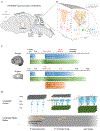Emerging connections between cerebellar development, behaviour and complex brain disorders
- PMID: 30923348
- PMCID: PMC7236620
- DOI: 10.1038/s41583-019-0152-2
Emerging connections between cerebellar development, behaviour and complex brain disorders
Abstract
The human cerebellum has a protracted developmental timeline compared with the neocortex, expanding the window of vulnerability to neurological disorders. As the cerebellum is critical for motor behaviour, it is not surprising that most neurodevelopmental disorders share motor deficits as a common sequela. However, evidence gathered since the late 1980s suggests that the cerebellum is involved in motor and non-motor function, including cognition and emotion. More recently, evidence indicates that major neurodevelopmental disorders such as intellectual disability, autism spectrum disorder, attention-deficit hyperactivity disorder and Down syndrome have potential links to abnormal cerebellar development. Out of recent findings from clinical and preclinical studies, the concept of the 'cerebellar connectome' has emerged that can be used as a framework to link the role of cerebellar development to human behaviour, disease states and the design of better therapeutic strategies.
Conflict of interest statement
Figures




References
-
- Piaget J The origin of intelligence in the child. (1953).
Publication types
MeSH terms
Grants and funding
LinkOut - more resources
Full Text Sources
Medical
Research Materials

